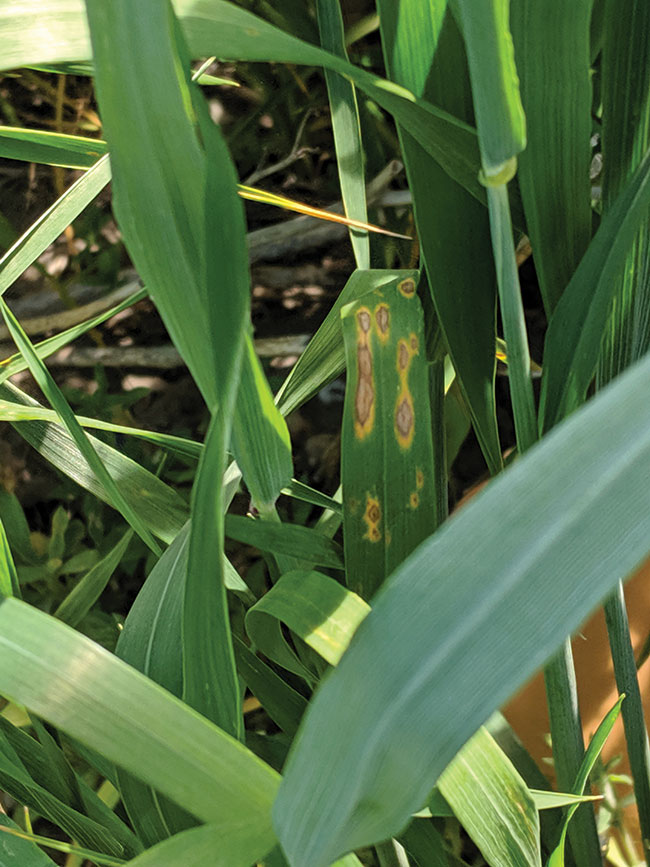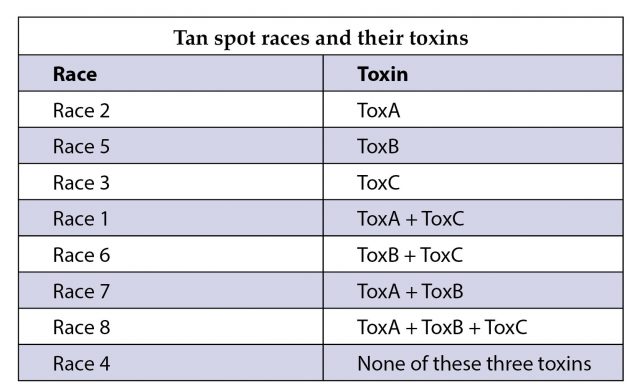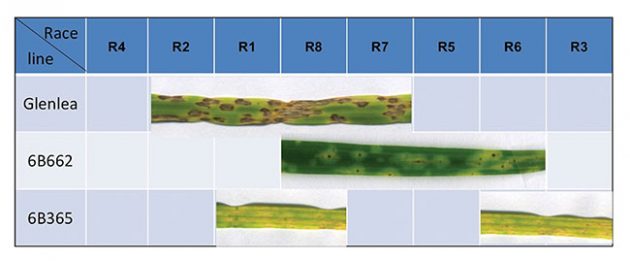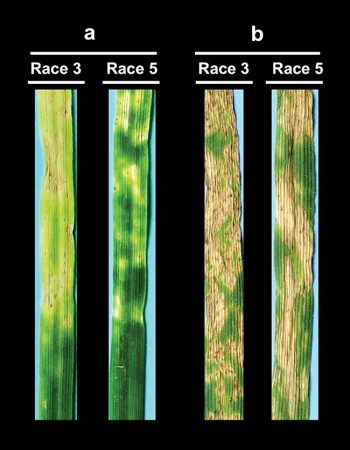
Features
Advancing tan spot resistance
New information on the resistance/susceptibility of Prairie wheat and fresh insights into the pathogen’s interactions with durum.
October 24, 2020 By Carolyn King
 Most wheat cultivars registered in Canada are susceptible to tan spot. Photo courtesy of Reem Aboukhaddour.
Most wheat cultivars registered in Canada are susceptible to tan spot. Photo courtesy of Reem Aboukhaddour. Sometimes what we think we know isn’t really so. Cereal pathologist Reem Aboukhaddour’s project on tan spot resistance in durum and winter wheat reveals that some long-standing assumptions about this fungus’s interactions with wheat don’t actually apply to all types of wheat.
Based on her previous research and hints in the scientific literature, Aboukhaddour had suspected that durum-tan spot interactions might be somewhat atypical. “But what sparked this project was when growers asked why durum seems to be more susceptible to tan spot than bread wheat,” she says.
Tan spot on the Prairies
Most wheat cultivars registered in Canada are susceptible to tan spot. The main goal of this project is to provide more and better information to help durum and winter wheat breeders develop tan spot-resistant varieties.
“Tan spot of wheat is one of the most destructive foliar diseases of wheat, not only in North America but worldwide,” says Aboukhaddour, a research scientist with Agriculture and Agri-Food Canada (AAFC) in Lethbridge, Alta.
Leaf symptoms include necrosis (tan-coloured lesions, the dead tissue) and chlorosis (yellowish lesions). As the infection progresses, all the lesions merge together and the leaf becomes necrotic eventually.
Tan spot is caused by Pyrenophora tritici-repentis. According to Aboukhaddour, scientists first described this fungus on wild grasses in the early 1900s, before it was known to attack wheat. Then in the late 1930s and early 1940s, some localized outbreaks of the disease in wheat were reported in Manitoba and Saskatchewan.
“This disease became an economic issue in wheat production in the U.S., Canada and Australia in the 1970s,” she notes. “Tan spot is a stubble-borne pathogen, and in the ’70s there was a strong trend to minimum tillage to prevent soil erosion. With more crop residue cover, the pathogen could overwinter and increase its inoculum. Also, at that time in North America and Australia, we had a few major cultivars that were grown over very wide areas, and those cultivars happened to be susceptible to the pathogen. With susceptible hosts, pathogen inoculum and conducive conditions, tan spot emerged as an important disease in North America and Australia.”
Race categories with a bread wheat slant
Like some other fungal species, Pyrenophora tritici-repentis produces what used to be called host-selective toxins and are now known as necrotrophic effectors. A host-selective toxin or effector causes disease in a plant only if that plant has a specific receptor gene that corresponds to that particular toxin.
So far, three tan spot toxins have been identified: ToxA, ToxB and ToxC.
The race of a tan spot isolate depends on which toxin(s) it produces. Aboukhaddour notes that much of the tan spot research during the past 40 years has focused on spring bread wheat. As a result, the system to identify tan spot races is mainly based on bread wheat.
Researchers use a set of three bread wheat genotypes, called differential lines, to determine an isolate’s race based on the symptoms produced on each line. These lines are: Glenlea, 6B662 and 6B365. Each line is sensitive to one toxin only. ToxA causes necrosis on Glenlea, ToxB causes chlorosis on 6B662, and ToxC causes a different kind of chlorosis on 6B365.
Based on the ability of the pathogen to produce combinations of these toxins, there are eight races. Some races produce only one toxin: race 2 (ToxA); race 3 (ToxC); and race 5 (ToxB). Other races produce two toxins: race 1 (ToxA and ToxC); race 6 (ToxB and ToxC); and race 7 (ToxA and ToxB). Race 8 produces all three toxins. Race 4 produces none of these toxins.
Tan spot surveys in Canada have mainly sampled bread wheat fields. In those surveys, five of the eight races have been reported. “Race 1 and race 2 are the most dominant. Race 3 is present at a much lower frequency. Race 4 and race 5 are extremely rare,” Aboukhaddour says .
So tan spot in Canada is mainly a ToxA and ToxC producer, while ToxB-producing isolates are almost absent. This is also true for tan spot in the U.S. and Australia.

Table courtesy of Reem Aboukhaddour.
“In Canada, the U.S. and Australia, ToxA is very significant; it can contribute to about 60 per cent of the disease on bread wheats,” she notes.
People have tended to assume that tan spot-wheat interactions are the same whether the wheat is bread wheat or durum. But durum is a different species from bread wheat, and Aboukhaddour noticed some indications that durum interactions were a little different.
“One indication was that some of the races found in these surveys, including race 3, race 4 and race 5, were not collected from bread wheat, but rather from durum or grasses,” she says.
“For instance, in 2013 when I was at the University of Alberta, I characterized tan spot races from across Alberta. They were mostly isolates from spring bread wheat. We found that 62 per cent of isolates were race 1, 36 per cent were race 2, and only 2 per cent were race 3. But all of those race 3 isolates were collected from the few samples we got from durum.”
As well, Aboukhaddour knew of examples in the scientific literature of tan spot isolates that didn’t fit neatly into the eight-race system. She gives one example: “Some isolates found in the U.S. and other countries cause a race 2 reaction on the differential lines, and yet those isolates lack the ToxA gene so they can’t be race 2.”
Aboukhaddour suspects these and other atypical isolates have probably been present in the pathogen’s population for years. They just haven’t been on our radar.
“I have found the eight-race system very useful and fundamental. It has led to a lot of fundamental understanding of the pathogen and the receptors in wheat corresponding to the toxins. However, it doesn’t explain everything,” she says.
She adds, “How can breeders develop resistance to something if we don’t know it is there?”
So, Aboukhaddour decided to try thinking beyond the assumptions in the eight-race system in her project on tan spot resistance in durum and winter wheat.
About the project
The project aims to: increase knowledge of tan spot’s race composition on spring durum, winter bread wheat and native grasses in Western Canada; identify sources of tan spot resistance in spring durum and winter bread wheat breeding lines; and increase understanding of durum-tan spot interactions.
Aboukhaddour targeted durum because of the signs that it might have atypical reactions to some tan spot races. She included winter wheat because it is an important crop on the southern Prairies and little information was available on tan spot resistance in western Canadian winter wheat lines.
She was also curious about tan spot races on native grasses. “We have many possible tan spot hosts on the Prairies – wheat, grasses and other cereals. It is useful to understand the pathogen on all of these hosts. Recently, in collaboration with researchers at the University of Alberta and in the U.K. and Japan, we found a dominant susceptibility locus [a location on the genome] in barley that interacts with race 5 (ToxB). This is first to be described in barley and, although the interaction of race 5 on some barley lines is described as mild chlorosis, the unique specificity between tan spot and barley confirms the adaptability of the tan spot fungus on other Prairie hosts aside from wheat. So I wanted to learn more about the pathogen on other non-wheat hosts.”
Funding for this three-year project (2017 to 2020) is from the Alberta Wheat Commission and the Saskatchewan Wheat Development Commission, with in-kind support from AAFC.
In 2017, Aboukhaddour and Myriam Fernandez, a research scientist at AAFC-Swift Current, collected samples of tan spot-infected leaves in southern Alberta and Saskatchewan.
Aboukhaddour’s group isolated 144 tan spot isolates from these samples: 71 from durum, 54 from winter wheat, and 19 from native grasses. They tested the isolates on the three differential lines to determine the race of each isolate.
Then they used PCR (polymerase chain reaction) methods to detect the presence of the genes for ToxA and ToxB in the isolates. (PCR tests are not yet available for the ToxC gene.)
Next, the researchers evaluated the response of durum and winter wheat lines to inoculation with race 2 (ToxA), race 3 (ToxC), and race 5 (ToxB). Then they used PCR tests to look for Tsn1, the dominant susceptibility gene for ToxA, in each line.
Aboukhaddour obtained the durum lines for the project from the durum breeder at AAFC-Swift Current, Yuefeng Ruan. He provided 40 durum genotypes that he often uses for crosses in his breeding program.
Robert Graf, the winter wheat breeder at AAFC-Lethbridge, provided 75 winter wheat lines for the project. These include the main western Canadian lines that he currently uses for crossing, as well as some eastern Canadian lines and some international germplasm, mainly European lines.

Reaction of the differential bread wheat lines to the eight tan spot races (empty cells indicate resistant reaction). Credit: Adapted with modification from Strelkov and Lamari (2003) and courtesy of Reem Aboukhaddour.
Highlights of findings
Overall, the project’s results confirmed what Aboukhaddour and durum growers had suspected: tan spot’s interactions with durum are different from its interactions with bread wheat.
Race composition in the field: The race composition in the sampled winter wheat fields was similar to that found in previous surveys of Canadian spring bread wheat: about 60 per cent race 1 (ToxA + ToxC) isolates and about 30 per cent race 2 (ToxA) isolates. No race 3 was detected.
The race composition in the durum fields was somewhat different. Race 1 and race 2 each represented about 45 per cent of the isolates, and about 8 per cent of the isolates were race 3 (ToxC).
Susceptibility in breeders’ lines: About 60 per cent of the western Canadian winter wheat lines were susceptible to race 2 (ToxA), which was at least twice as high as the percentages in durum and in the eastern Canadian and European winter wheat lines.
Susceptibility to race 3 (ToxC) in the Canadian winter wheat and durum lines was almost equal, at about 20 per cent, which was twice the percentage in the European germplasm.
Susceptibility to race 5 (ToxB) was higher in the durum lines (33 per cent) than in the Canadian bread winter wheat lines (6 per cent).
Symptoms in susceptible lines: As expected, race 2 caused necrosis on winter wheat and durum.
Races 3 and 5 caused the expected chlorosis on winter wheat. However, on durum, both races caused extensive necrosis on a considerable number of the tested lines.
So each of the three toxins caused necrosis on susceptible durum lines.
Tsn1 tests: “While in rust and other pathogens we often talk about dominant resistance genes in the wheat host, in tan spot we have the inverse case of dominant susceptibility genes in wheat conditioning the susceptible interaction. Tsn1 is the only gene conditioning sensitivity to ToxA in wheat,” Aboukhaddour explains.
“In this project, Tsn1 was more prevalent among the Canadian wheat genotypes (51.2 per cent in winter bread wheat and 59 per cent in durum) than in the European genotypes (21.7 per cent).
“However, half of the durum lines carrying Tsn1 were unexpectedly resistant to race 2, the ToxA-producing race.”
Interestingly, when some of the durum lines with Tsn1 were injected with ToxA by itself, they showed susceptibility to ToxA. But when those ToxA-sensitive durum lines were inoculated with an actual race 2 isolate, some proved to be resistant to race 2. So durum seems to have some different way of resisting race 2 that doesn’t involve the Tsn1 gene for sensitivity to ToxA.
“These results agree with recently published findings from a group of researchers at North Dakota State University and the USDA in North Dakota,” she notes. “Those researchers have concluded that the Tsn1-ToxA interaction does not play a major role in tan spot susceptibility in durum wheat.”
Native grasses and race 4: “We collected samples from a single field with native grasses near our research centre at Lethbridge. Every one of the 19 isolates that we characterized from those native grasses was race 4,” Aboukhaddour says.
Race 4 does not produce any of the three known toxins and is considered non-pathogenic in the current race system. However, the North Dakota research group recently reported that race 4 can cause extensive necrosis on durum wheat. They think race 4 likely produces some not-yet-identified toxins to which durum is sensitive.
“Until now, people hadn’t considered race 4 to be important. In over 40 years of tan spot surveys in Canada, only one or two race 4 isolates had been collected because the surveys have always concentrated on bread wheats,” says Aboukhaddour.
“Since we now know race 4 is part of the fungus’s population in Canada, it would be wise to look at race 4 in Canada, especially in relation to durum.” She is planning to test race 4 on Canadian durum lines.

Aboukhaddour’s study found that races 3 and 5 caused the expected chlorosis on winter wheat (a), but caused necrosis on durum (b). Photo courtesy of Reem Aboukhaddour.
New research areas opened up
Aboukhaddour is currently finishing up this project and preparing some papers on the results. As well, she is already working on some of the new research areas opened up by the project’s results.
As part of another leaf spot project, she is investigating durum’s necrotic reaction to race 3. She sees a couple of possible reasons for durum’s atypical response to this race.
“One possibility is that durum is more susceptible to ToxC – perhaps it has more ToxC receptors – and durum’s reaction to ToxC is exhibited as necrosis, which is a stronger reaction than the chlorosis we find in bread wheat,” she hypothesizes. “Or perhaps, in addition to ToxC, race 3 produces some necrosis-causing toxin(s) to which durum is susceptible.”
She hopes to purify the necrosis-causing factor in race 3 and identify the durum loci that interact with it. Finding the loci would be the first step in developing markers so breeders could screen durum lines for susceptibility or resistance to the toxin.
Benefits, synergies, advances
Aboukhaddour is sharing the project’s results with wheat scientists. “The breeders will now know which of their lines are susceptible and which are resistant to tan spot,” she says. That information is critical for developing the tan spot-resistant lines that western Canadian crop growers need.
The project’s findings regarding durum’s atypical responses to the different races and the presence of race 4 on native grasses are increasing our understanding of the pathogen on the Prairies and its interactions with different hosts.
These findings also align with other projects in Aboukhaddour’s lab at AAFC-Lethbridge, her collaborative projects with other researchers, and studies by the North Dakota group. “Having all these parallel projects on tan spot-host interactions makes the project’s findings stronger,” she says. “I was thrilled to see other researchers looking into the unique interactions between tan spot and durum because it gave me more confidence and hope to open more doors for collaboration with different groups with same interest.”
She adds, “When I started this project, I was challenging some preconceived thoughts about tan spot. But it was very important to take into account the growers’ observations about tan spot in durum and the already reported observations in the literature. We don’t have to be bound by our previous definitions and assumptions.”
By thinking beyond the traditional eight-race system, Aboukhaddour and others have been able to work towards a deeper understanding of tan spot. And that deeper understanding will further help scientists in targeting effective resistance in new cultivars.